BALTIMORE (WJZ) — A construction worker was killed instantly after he was hit in the head with a crane holding 13,000 pounds of cement in Harbor East Friday morning.
It happened around 7:30 a.m. in the area of Aliceanna Street and South Central Avenue, Baltimore Police tell WJZ.
The victim was 44 years old. Police suspect no foul play. The development of the site is being done by the Harbor East Management Group and the Bozzuto Group. Representatives for the property management group released the following statement Friday afternoon.
“We regretfully report that at approximately 7:30AM, an employee of a subcontractor was tragically killed while working on the Liberty Harbor East construction site. Emergency responders were called to the site and the individual was pronounced dead at the scene. Representatives from Maryland Occupational Safety and Health (MOSH) have conducted an onsite review and their investigation is ongoing. The name of the individual is being withheld until the family has been notified.”
=============
BALTIMORE —
A construction worker was killed in Harbor East Friday morning, police said.
Baltimore City police were called at 7:30 a.m. to the Liberty Harbor East construction site on South Central Avenue.
A crane operator was swinging a bucket of cement when it struck the victim in the head, police said.
The victim, a 44-year-old man, was pronounced dead at the scene.
Police said it appears to be an accident and no foul play is suspected.
The developers released a statement, saying:
"We regretfully report that at approximately 7:30 a.m., an employee of a subcontractor was tragically killed while working on the Liberty Harbor East construction site. Emergency responders were called to the site and the individual was pronounced dead at the scene. Representatives from Maryland Occupational Safety and Health (MOSH) have conducted an onsite review and their investigation is ongoing. The name of the individual is being withheld until the family has been notified. This is a heartbreaking tragedy and on behalf of Harbor East and Bozzuto our thoughts and prayers are with the family."
=================
In a ceremony tinged with both a celebratory and somber tone, the $170 million Liberty Harbor East development officially got underway Friday.
A groundbreaking complete with champagne and confetti was held at the site of the development by the Harbor East Management Group and the Bozzuto Group.
The project will hold 282 apartments and 35 condominiums in a 22-story tower at the foot of Central Avenue at Aliceanna Street. The ground floor and a mezzanine level will hold a massive Whole Foods market and other retail. The new store will replace a smaller Whole Foods located a block away that opened in 2002. The development will also have 575 parking spaces.
But as city officials joined the developers and other local business representatives to laud the opening of the two-year project, many took time to remember Harbor East's original developer John Paterakis Sr., who died Oct. 16. His family sat on the front rows underneath a tent pitched at the site for the event.
"We are celebrating in the shadow of a man," said Tom Bozzuto, chairman of the Bozzuto Group and a long-time business partner of Paterakis, who also owned the H&S Bakery. "Who showed us that by taking a risk on our city ... we take no risk at all."
Mayor Stephanie Rawlings-Blake christened the project by breaking a bottle of champagne on a steel sculpture that resembled the bow of a ship. After that, Bozzuto and others involved in the development team uncorked ceremonial champagne bottles filled with confetti.
Rawlings-Blake, too, recalled the life of Paterakis and his contribution to the city as developer of Harbor East at the insistence of former Mayor William Donald Schaefer. The area once held rotting wharfs and one-story industrial buildings and today is the location of some of the city's most upscale developments including the Four Seasons, Legg Mason tower and the Marriott Waterfront hotel.
"Mr. Paterakis would be proud of this development and its significance for the Harbor East neighborhood," the mayor said, of The Liberty. "I am proud to join ... with those gathered here today to recognize his many accomplishments and his strong belief in the future of Baltimore."
The Liberty Harbor East is named after Paterakis's sister, Liberty Tsakalos. It will be completed in two years and is located on a site formerly occupied by a distribution center for the bakery, which still uses several parcels of land in Harbor East and Fells Point to bake and distribute bread and rolls.
Hickok Cole Architects designed the modern building and Stonehill & Taylor will design the interiors. Bozzuto will also manage the building as well as serve as general contractor.
Amenities at The Liberty Harbor East include a yoga studio, dog park, gaming area, outdoor theater and lounge and bar.
Matt Ray, regional vice president of Whole Foods Market, said the company was eager to open an expanded space in the area, remarking on the incredible growth in Harbor East.
"Let's get this thing started," he said.
A total of 500 construction jobs are expected to be created at the development, officials said. Consistent with statistics at construction sites, a number of death and injuries will happen over the duration of the project.

































